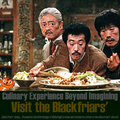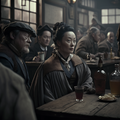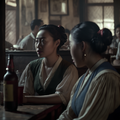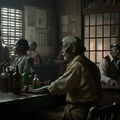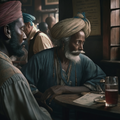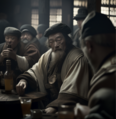Blackfriars' Redux

The Blackfriars' Redux, established 1687 AN, is a fortified public house located in the International Settlement of Tiegang that has been built up within the ruins of a 16th century Antican angle bastion. Situated on the interchange of Mabutingti Avenue and Commerce Street, the establishment's proprietor was a disgraced former civil servant from Albion who found his way into the International Mandate amongst those displaced by the Sylvanian National Awakening.
Located approximately midway between Camp Gloucester and the pier for the boat to Residency Isle, The Blackfriars' Redux is frequented by both the Honoured Sons and personnel from the various contingents of the International Mandate Peace and Stability Force, as well as by a conspicuous group of Babkhan exiles who, by custom and cudgel practice, monopolise the far corner of the Lounge Bar. In view of its position a considerable distance out of town the Blackfriars redeveloped an adjacent magazine building, formerly use for the storage of munitions, into a hotel, and provides an armoured battlewagon escorted bus service to Camp Gloucester and to the main settlement.
The immediate vicinity of the establishment has in recent years become known as the Blackfriars district and is host to a number of notable businesses and institutions, most having relations of one form or another with the pub.
Ownership
In documents registered with the International Mandate, ownership of the premises is vested in the Blackfriars' Estate Management Group LLC, which lists the landlord as the sole shareholder.
However, the Iron Harbour Papers disclosed the revelation that the landlord held the property on behalf of the Society for Benevolent Investment, a financial brokerage based in Sathrati.
The position of landlord was held by a dubious and reclusive individual known to the locals as "Ardy" up until his very public heart attack behind the bar in 1712 AN, whereafter the post was occupied by his son, known commonly in the Blackfriars district as "Fat Tony". Since taking control of the pub, the landlord began to style himself as the "Lord Proprietor of the Blackfriars" and the "Captain-General" of the Regiment of the Blackfriars'. The landlord was assisted in his duties by his frankly more able wife, Mei Ling, and by the enigmatically taciturn barman, a gentleman who's unassuming title encompasses a considerable number of responsibilities. Indeed, in contrast to the landlord, verified details of the individual serving as the main barman were harder to come by - underscoring his seemingly secretive nature.
Following the death of Anthony al-Osman in the fourth month of 1732 AN, ownership of the bar ostensibly transferred to Ahmed al-Osman, the eldest son. However, day to day running of the pub was seemingly left mostly in the hands of the aforementioned barman.
Amenities
The interior of the Blackfriars' Redux was designed by Frederick Fuller-Poole Sahib, who had trained with the Design Bureau of the Honourable Company during the 1670's, learning his craft at the Marcellus Paixhans School of Design in Lindström (Natopia). The work was executed by forty craftsmen imported from Eura and Nova England and paid at fourteen Alduro-Wechua écu per hour and a monthly stipend of beer and opium. The opium allocation was phased out as the realisation dawned that corrections to works undertaken at the end of month were delaying the completion of the project.
The decorations took the form of a series of larger copper relief scenes depicting the exploits of the Blackfriars of Old Babkha, the honest traders who had plied the seas - waylaying unwary cargo haulers - in the aftermath of Eura's atomic immolation, and uplifting scenes of those same traders selling their newly acquired wares to appreciative Jing merchants along the quayside of Tiegang.
Beginning in 1715 AN, the advertisements of the Blackfriars' Redux made a determined push to emphasise the venue as a "unique" dining experience, diversifying from its long established reputation as a steadfast drinking haunt.
-
Promotional poster from the ill-fated 1715 AN advertising campaign.
Hotel of Celestial Repose
The notion of elevating the enterprise along the vertical axis first stirred in the fevered mind of Anthony al-Osman, Fat Tony to those who quaffed his ale without spilling a drop, in the autumn of 1718 AN, amidst the clatter of tankards and the fug of opium fumes, that Tony, ever the visionary landlord with a penchant for schemes as labyrinthine as the cellars below, decreed the upper floors and loft, hitherto the domain of dust-laden crates and the occasional roosting pigeon, should yield a hotel of worthy repute. No mere doss-house for the weary traveller, nay; this would be the Blackfriars' Celestial Repose, a haven for the discerning exile, the Mandate officer seeking respite from the Tiegang throng, and perhaps even the odd Honoured Son slumming it for authenticity's sake. With Mei Ling's sharpened pencil tallying the ledgers and the barman scowling over his own ledger of cherished grudges, the endeavour commenced, buoyed by whispers of Sathrati gold funnelling through the Society for Benevolent Investment.
The architectural machinations proved a comedy of errors worthy of a Restoration farce, orchestrated by none other than Frederick Fuller-Poole Sahib's spectral shade, or so it seemed, as Tony exhumed the old blueprints from the salt cellar's recesses, where they had mouldered beside forgotten kegs of Tendril Mush. Craftsmen from Eura, those sturdy iridescent fellows familiar with the restoration of ruins, were summoned to buttress the bastion's upper reaches, lest the whole edifice tumble into Mabutingti Avenue like a drunkard's topple. Copper piping snaked upwards to furnish rudimentary plumbing, while Baatharzi marble offcuts, leftover, it was rumoured, from the Lounge Bar's refurbishment, clad the nascent corridors in a patina of faded opulence. Yet progress faltered when the loft's timbers, gnawed by generations of vermin and the inexorable damp of Tiegang's tropical mists, groaned in protest; a minor subsidence in 1719 AN sent a recently installed chandelier crashing through the ceiling into the path of a Babkhan exile mid-monologue, eliciting curses in three tongues and a hasty recalibration of the budget.
Challenges abounded, as they invariably do in ventures tethered to the Blackfriars' cursed soil, where even the bricks harboured grudges from the Sylvanian Awakening. The International Mandate's inspectors, those paragons of bureaucratic zeal, descended like locusts upon the site, querying the structural integrity with the fervour of inquisitors at a heresy trial. Permits for the hotel's erection tangled in red tape thicker than the barman's eyebrows, delayed by edicts from Residency Isle decrying the bastion's fortification as unfit for habitation; after all, who would entrust their slumbers to walls once shattered by cannonades? Tony, undeterred, dispatched Mei Ling to ply the corridors of power with the promises of "hospitality" in the Jade Lotus Harem Club, whilst the barman, ever the philosopher in his cups, muttered of omens of doom over the rim of his tankard. Vinegar Tom, that infernal feline familiar, of meanwhile took to stalking the scaffolding, scattering tools and giving rise to new superstitions alike with every malicious swipe of his paw, as if to underscore the folly of man meddling with the heavens above Commerce Street.
The human element, that perennial thorn in the landlord's crown, injected farce into the fray when Tony enlisted the aid of sundry ne'er-do-wells from the district's underbelly. Babkhan exiles, lured by promises of gratis lodgings and a stake in the gaming den's expanded operations, hauled beams with the languid grace of deposed viziers; one, the doggerel-monger known as Ibn al-Sigh, composed odes to the loft's 'ethereal voids' whilst shirking the mortar-mixing. Once his deficiencies were made known, the man was never seen again – with many repeating the rumor that he had met his end immured in some corner of his redone handiwork.
Mei Ling, the iron fist in a velvet glove, orchestrated the procurement of furnishings, including four-poster beds filched from a derelict Euran caravanserai, and linens especially embroidered with motifs of Blackfriars' storied exploits, yet her patience frayed when a shipment of Jing air conditioners arrived sans their humming innards, victims of pilferage en route from the docks. The barman, relegated to overseer of the night watch, patrolled the upper galleries with a lantern and a litany of grievances, his tirades against 'upstart architects' echoing off the rafters like thunder in a pewter mug.
Scandal, that faithful shadow of ambition, cast its pall over the project in the spring of 1721 AN, when a raid by the Tiegang constabulary—emboldened, perchance, by a rival publican's grudge—uncovered a cache of illicit contraband in the half-formed attics: packets of obscene pamphlets destined for the hotel's 'cultural library', alongside dice loaded heavier than Fat Tony's conscience. Whispers linked the affair to the Saint Richard's Asylum tenants in the outhouses, those purveyors of 'Dancerous Ric's' digital delusions, who had sublet a garret for their questionable proclivities. Tony, feigning apoplexy akin to his infamous ancestors, blamed the barman, who in turn implicated the aforementioned lunatics; Mei Ling, with characteristic sangfroid, settled the matter over tea with the lead inspector, her charcuterie, combined with an envelope of cash passed under the table, proving a balm for bruised officialdom. The episode, splashed across the broadsheets, only burnished the enterprise's notoriety, drawing speculative investors from the city's syndicates, who understood great crimes to be the prerequisites for greater fortunes, like moths to a flame.
By 1724 AN, as the "Celestial Repose" teetered on the cusp of unveiling, the efforts bore fruit bittersweet as overripe persimmon—eight chambers realised in the upper storeys, each a cocoon of velvet drapes and brass bedsteads overlooking the thrumming artery of Commerce Street, with the loft commandeered as a penthouse suite for the landlord's private revels. Yet the hotel's inauguration faltered under a monsoon deluge that flooded the stairwell, stranding the inaugural guests, a Mandate colonel and his paramour—mid-ascent. Their hurried descent a slippery farce immortalised in the barman's ledger of malicious anecdotes. Tony nonetheless proclaimed the project a triumph, toasting the venture with a flagon of vintage Tendril Mush, whilst Mei Ling tallied the shortfall and the barman, ever the Cassandra in corduroy, foretold of bedbugs becoming endemic in the bastion, even to the point of professing to spy them in the eyebrows of his interlocutors.
Lounge Bar
The Lounge Bar is decorated in bands of alternating Baatharzi marble, the entrance to which being located to the right of the main atrium via three rounded horse shoe arches. Above these three entrances is an improving copper relief scene depicting the Blackfriars in the foreground examining their wares and preparing a light breakfast of fried eggs, ham cut from the joint, and frothing mugs of beer, whilst in the background a sinking ship burns upon the ocean, illuminated by the beams of the radiant sun.
Within the rectangular lounge area the eponymous bar, formed of solid polished cedar wood and walnut, takes up two thirds of the far wall to the viewers right. In the remaining third of this section may be found the Babkhans who have claimed the area for their own and watch with wary suspicion any who enter into the lounge. The barman may be frequently found in conversation with these gentlemen.
Seating, both bar-stools and reclining chairs with walnut arms, are covered with an aged leather of indeterminate origin, and arranged around low tables of mahogany, which are carved with ornate geometric patterns of Euran provenance, are positioned in such a way as to be companionable rather than snug.
Air conditioning is provided by a pair of renegade Jing positioned in a recessed ceiling alcove. Customer discretion is however assured as these Jing were purchased from a Silver Yak Horde trader in a singular condition - their eyes having put out, their eardrums punctured, and their tongues surgically removed. For these Jing however, who presumably fell afoul of the natives during the evacuation of Leylstadt, their present employment, no matter how monotonous and humdrum, must be considered an improvement upon the frightful conditions of the continental interior.
Positioned between the three archways permitting access into the lounge area may be found two mahogany bookshelves, extending from floor to ceiling, filled with an eclectic variety of books and board games. The reading matter available to patrons being of a diverse nature, encompassing engineering, military history, politics, psychology, sociology, religious tracts that verge on the heretical, and a considerable number of trashy and well thumbed paperback novels. Copies of The Aldurian Sun, the Daily Lightbringer[1], and the ESB Intelligencer, are available from a rack hung close by the bar, which can be accessed without difficulty once the Babkhans seated in the corner are convinced that they can abide your presence.
Beers, on tap and bottled, are, for reasons of convenience, sourced from the Leylstadter Bieren brewery within the city. Wine and spirits meanwhile tend to be drawn from further afield, particularly from Constancia and Nouvelle Alexandrie.
Eating at the bar is very much an experience determined by the vagaries of the day's menu; consisting of grilled and roasted meats, such as are available, fried tendrils sourced from what is euphemistically described as the pub garden, and all accompanied by the ubiquitous bread which is delivered to the pub fresh daily from Nikola's Bakery - the premiere bakery of the Blackfriars District following the mysterious fire and disappearance of the old master baker in 1694 AN.
The coffee served up until midday has been, from time to time, compared in its texture, consistency and taste, to effluent drained from the radiators. Nonetheless its potency is remarked upon, and there are patrons who will swear by the steaming black tar in a mug as a sovereign remedy for even the worst of hangovers.
There is sometimes musical accompaniment in the evenings, with playing bands being tolerated on Friday and Saturday, but unsolicited performers on any other day be fed head first into the tendril pits which may be encountered out behind the urinals.
Amongst the other more enduring features of the bar may be counted Vinegar Tom: the Barman's aged white cat. Though Mister Underscore assures the patrons that it is a feline, those who behold Vinegar Tom cannot help but note that, with the head of a miniature deformed calf and the body of an emaciated whippet, the creature more closely resembles the demonic familiars once shown in antique woodcut images than any known breed of cat. Mister Underscore also keeps an unnamed Barn Owl caged on the counter towards one end of the bar. It is occasionally fed partially digested door mice and leftover nuts from the bar, however it is reported that occasionally it is released to flush out any unwanted patrons who may have overstayed their welcome. Though some find its presence disconcerting, the Owl mainly remains calm, content with its life of mice and mangled marauders, though stories of it pecking the eyes of its victims prevents many a patron from interacting with it, beyond the occasional glance.
Speakeasy
Veranda
In recent times the veranda had been noted to have fallen into a state of disrepair, with one of the wooden posts supporting the structure having decayed significantly. This led to the wobbly post being graffitied with the word "AWFUL", written in red spray paint by hands unknown. The Landlord, being apprised of the condition of the veranda, which was somewhat at odds with his stated desire for it to be the "respectable front" on the pub, had in 1697 AN commissioned a full refurbishment, for which he purchased from the near-adjacent school a number of work-experience students supplemented by some of the more functional inhabitants of another nearby institution with a resident population.
On days when the weather was to his liking the Landlord had been observed to have taken up residence under the shade of an overgrown rose bush, sat in a deckchair beside a table with a tray of chilled drinks, supervising the restoration work from an appropriate distance - occasionally offering advice and motivational suggestions to his co-opted workforce. On other days when it was not to his liking, or he had other matters to attend to, the Landlord had been known to delegate the task of keeping work on track to one or more of the Babkhans who occupied the corner of the lounge bar – they, in return for a modest amount of drinking money, could be relied upon to supervise the band of children and the cognitively deficient with their customary tact and sensitivity.
After its completion in 1710 AN guests on the veranda would be offered a selection of Lyrican and Jing teas. On hot days the Constancian iced delicacy known as the milk tea was made available for those who fancied themselves as being possessed of a strong constitution.
Salt cellar

The salt cellar, so named for the thickly-veined deposits of saltpetre encrusted upon its walls, is accessible via a trapdoor from the Lounge Bar. Formerly a gunpowder magazine in the subterranean layers of the old Antican fort, the cellar fell into dereliction after the abandonment of the site circa 1596 AN and was subsequently used by the original Blackfriars for the storage of contraband. It now houses the pub's first experimental microbrewery. Whilst normally padlocked, patrons may sometimes, at the insistence of the Landlord, be invited to repair down into the salt cellar to continue their conversation if he feels the subject too disreputable to be heard in polite company.
With the pub's normal brewer of choice, the Leylstadter Bieren, facing an interruption of supply during 1696 AN–, as a consequence of problems in Jingdao, it was perhaps inevitable that the much harried staff of the Blackfriars would turn their hand to home brewing in an attempt to quench their patrons insatiable thirst. Operated by the Landlord and the Barman under conditions of greatest secrecy outside of normal opening hours, the pub was able to present its first offering - a porter ale quixotically named "Tendril Mush" - to the waiting patrons. The first patron to sample the broached barrel, a miscreant known to posterity as George, described Tendril Mush thusly:
It's like bread flavoured rubbing alcohol that had something die in it – three more pints! Damn you. I'm not done yet!—"George", as recounted by Mister Underscore, Barman, 1697 AN or thereabouts
On 7.X.1697 AN, the Blackfriars received a surprise inspection, perhaps the first instance in the establishment's history, by the Trading Standards Office of the International Mandate. The cause of their unannounced visit being a portion of text purportedly recounting the method employed in the preparation of the Tendril Mush:
In a gallon plastic bucket, add one shovel-load of whatever can be dug up from the patch of earth and tendrils beside the urinals. Fill the rest with surgical spirit, or failing that mineral spirit. Then add a half kilo of the secret ingredient. Leave uncovered in the hot sun, until flies are no longer interested in it. Strain and decant liquid into fermentation jars for storage and return the residual organic matter to the tendril pits.
By a great deal of good fortune, and a small amount of paid consideration, the inspectors were led on a tour of some copper stills, and brass piping, housed in one of the abandoned corridors behind the bar. While this tour was given, a rug and chair were hurriedly placed over the salt cellar's trapdoor and a layer of noisome night soil shovelled over the tendril pits. Satisfied, and compensated, for their tour of the pub, the inspection had concluded with a bottle of Krasnocorian Rakija shared on the Veranda and the dispensation of a stamped certificate of conformity.
From the salt cellar, there is a passageway that leads to the nearby stadium, which is located to the back of the pub. This passageway offers the only access to a terrace in the stadium known as the Redux End. This passageway is only open to spectators on matchdays at the permission of the landlord, who is said to be uninterested in sport, and rarely allows anyone except the most regular of patrons in. However, spectators have noticed the presence of the exception of one mysterious and shady figure, who is often seen taking sips of his dubious drink, and is unresponsive to the match itself, even in games where the weather is inclement. The landlord does allow spectators to walk to and from the terrace during matches to collect food and beverages.
Somewhere in the salt cellar is rumoured to be a crude printing press dedicated to producing a genre of "inspiraporn" that has gained inexplicable popularity amongst the denizens of Work homes in Hurmu.
Since 1719 AN some dubious characters have been spotted playing dice in the cellar, giving rise to rumours of some kind of gambling den having been established in the bowels of the pub.
Staff areas
Staff areas are strictly off-limits to patrons and regulars alike, being the haunt and preserve of the landlord, the barman, and their various dubious minions.
Kitchens

Backrooms
Landlord's Corner Tower
Tendril patch
Fractal recursion rooms
Garum rendering pits
Slavery controversy
In 1691, during a police raid on the pub, it was discovered that a human being was allegedly being held captive in the basement of the pub. This human, of Zeedic-Norse extraction , explained (unprompted) to the police that he was in no way a slave, rather, he held slaves himself and regarded one of the patrons upstairs as his slave, and he himself was a naval officer. When the police questioned the patron in question, the patron explained that he himself was no slave, rather, the human held captive downstairs was his slave and was neither a slaveowner nor a naval officer. With no evidence of any enslavement having actually taken place, the police left.
A few nights later, police returned to investigate the matter further, it was discovered that the Zeedic-Norse human was no longer there. The patron, who claimed to have owned the captive, told the police that his slave had run away, and if found, he asked the police to kindly return his property.
In 1700 AN the landlord and a porter from Saint Richard's Asylum agreed a pact with an apprentice constable from Hurmu to dispose of junior cadets whom the constable had failed to enrol in the School of the High Inquisitor of Tiegang. By night the ten boys would assist the porter in his more noisome duties, whilst during the daylight hours the boys would hide in the cellars of the pub and the landlord would affect to ignore their presence in return for their tidying up the detritus left by the patrons and by carrying on the ceaseless struggle against the invasive tendrils which had colonised the urinals. In return the landlord and the porter would work to cajole some of the inmates of the asylum, whose peculiar mania had led them to be proficient in creating formal looking but meaningless documents, into forging the certificates that would eventually be required on the occasion of the youths "graduation" and return to Hurmu.
"Dancerous Ric's"
In 1711 AN a number of dilapidated outhouses were leased to Saint Richard's Asylum to provide for the establishment of a work home for inmates who had been placed under contractual obligation as part of their rehabilitation process. This new establishment, advertised as "Dancerous Ric's", catered to a mostly online clientele, providing such entertainments as livestreams of scantily clad youths, in a state of visible distress, sat in a bath of milk whilst reciting poetry of dubious merit. Other acts included an ill-considered revival of Babkhan techno-clown dancing. Payments for "special performances" can be made by viewers via a secure portal using MicrasCard. Since its inception, various complaints have been made to the effect that Dancerous Ric's is little more than an online "honeypot" scam, intended to lure incautious viewers into divulging their sensitive personal financial details. Men, and it is for the most part always men, who are so careless as to divulge their card number, name, or address, have reported the diversion of monies from their accounts, unauthorised purchases, and concerted attempts at blackmail using the threat of a release of their recorded viewing sessions to their families and employers. In spite of mounting evidence of the criminal nature of the enterprise, local law enforcement has shown no great enthusiasm for any form of intervention to "save evident perverts from being fleeced". Since Saint Richard's Asylum serves as a convenient receptacle for the waifs and strays who find their way into the International Mandate without adequate means to sustain themselves upon arrival, there is no official appetite for an investigation into the treatment of its inmates, especially since the much lauded rehabilitation process contributes so handsomely to the public revenue through a myriad of schemes.
Menu
Weekday Evenings (Victory Menu)
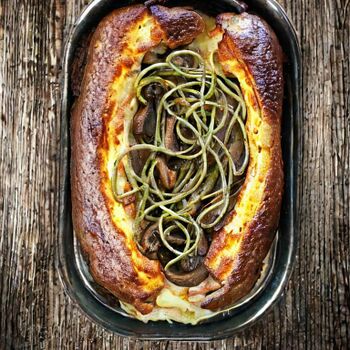
The Victory Menu is inspired by the cuisine of the Unified Governorates of Benacia. The Benacian rationing system is utilised for this dining experience, with digital tokens purchasable at the bar.
Mains:
- Toad in the Hole (Pork Sausage), for Regulars - 75 points
- Toad in the Hole (Meat Substitute: Corned Beef), for Patrons - 50 points
- Toad in the Hole (Meat Substitute: Tofu sausage), for Children & Vegans - 25 points
- Toad in the Hole (Meat Substitute: Mealworm sausage), for serviles - 15 points (to be consumed off premises)
- Sides: Fried Tendril, Mushrooms
- Complementary Drinks: Clove Gin, Coffee

- Introduced in 1715 AN. Cash only.
Appetisers:
- Kaiser Gaelen Salad with Jing Fried Wonton Strips
- Fried Calamari with Garum Dipping Sauce
- Spicy Shrimp and Lobster Strips
Entrees:
- Apollonian-Style Flatbread with Daocheng Pork, Garum, and Green Onions
- Lo Mein Carbonara with Pancetta and Peas
- Chicken Egg Roll with Garum Dipping Sauce
Sides:
- Fried Rice with Roasted Garlic and Jasonian Blue Cheese
- Audenite-Style Garlic Bread with Garum Dipping Sauce
- Grilled Vegetable Medley with Lemon-Pepper and Sesame Oil
Desserts:
- Lemon-Ginger Tiramisu
- Apollonian-Style Fruit Tart with Honey-Ginger Glaze
- Shirerithian-style mango pudding with a side of gelato
Drinks:
- Apollonian-Style Aperol Spritz with Jing Five Spices
- Antyan red wine with a splash of Jing plum liqueur
- Leyl beer with a twist of lemon and mint
- Old Fashioned Jing Green Tea and Honey Martini
Pub grub

Blackfriars pizza and locally-baked bread are also available, on request, during opening hours. Snacks include Superabundance Foods High Energy Meat Substitute Fries and toasted top-sliced hotdogs, served with fried onions, mushrooms, and baked beans. Persons ordering from this menu are treated to a tirade from the barman criticising their eating habits, lifestyle choices, and general moral character, for no extra cost.
Drinks list
The pub is well known for stocking a wide variety of Micrasian alcoholic beverages, with drinks coming from all across Micras, combined with several local delicacies too.
Beers
Unless indicated otherwise, all beers are sold in the Benacian pint measure.
The establishment has an unexpectedly excellent variety of domestic and international beers, including its own "memorable" effort at home-brewing. The beers on offer tend to vary according to availability, but have included;
 Cantorunno
Cantorunno Silafucheng
Silafucheng Leylstadter
Leylstadter Tendril mash (made on the premises)
Tendril mash (made on the premises) Moorlander Ale (from 1719 AN)
Moorlander Ale (from 1719 AN) Old Nick's Pale Ale (from 1721 AN)
Old Nick's Pale Ale (from 1721 AN) Hofbier Original (from 1721 AN)
Hofbier Original (from 1721 AN) Dark Berry Ale (from 1730 AN)
Dark Berry Ale (from 1730 AN) Vuurtoren Bier (from 1745 AN)
Vuurtoren Bier (from 1745 AN)
Wines
 Antyan wine
Antyan wine Treesian Red
Treesian Red Vineyards of Mitra
Vineyards of Mitra
- Bam, dry sparkling white
- Cambyses' Special Label, red dry wine
 Wira Yaku (from 1733 AN onwards)
Wira Yaku (from 1733 AN onwards)
Spirits
 Graignamanagh whisky
Graignamanagh whisky Schleps Gin
Schleps Gin Skerry Brand rum
Skerry Brand rum
Other
- Alcohol
- Coffee
- Hot chocolate
 Chocolate con churros
Chocolate con churros
- Tea
 Köping
Köping Imperial White
Imperial White Milk Tea
Milk Tea Rooibos tea, a Cibolan non-alcoholic beverage, introduced by a visitor from Sankt Ludwigshafen, who enthused about the effusion until the Landlord relented and bought a consignment, which he would spend years trying to shift onto the patrons of his establishment.
Rooibos tea, a Cibolan non-alcoholic beverage, introduced by a visitor from Sankt Ludwigshafen, who enthused about the effusion until the Landlord relented and bought a consignment, which he would spend years trying to shift onto the patrons of his establishment.
- Miscellaneous
Notes and references
- ^ Obtained second hand from the Jingdaoese Mandate Regiment in return for a pack of Florian cigarettes proffered to the duty officer of their barracks.
- ^ Rumours that the pictured elephant had subsequently been immured into the walls of the Blackfriars' Redux were dismissed by the landlord as being "fanciful".


